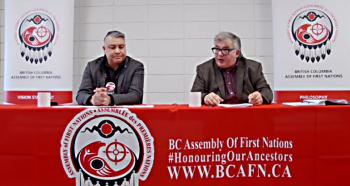Image Caption
Summary
Local Journalism Initiative Reporter
Windspeaker.com
Assembly of First Nations British Columbia (BCAFN) Regional Chief Terry Teegee isn’t considering taking legal action against Prince George, despite a safe streets bylaw that targets “de-housed” people in the northern city, the majority of whom are Indigenous.
“I think overall, more legal action doesn’t solve any of these issues,” said Teegee during a news conference on March 21.
The three-page bylaw sets out ways for the city to “regulate and control unlawful occupation” which includes taking measures to prevent panhandling; the obstruction of tents, blankets and other similar property in doorways, sidewalks or other public places; the use of drugs in public spaces; and open-air burning.
“I think there’s compromise everywhere in terms of finding a better solution,” said Teegee. “Maybe amendments to the bylaw itself, considering that the purpose of it was to try and deal with some of these issues.”
There is no social or health care aspect to the bylaw. The bylaw does not state it will provide support for homeless people, whether it be through taking them to shelters, getting them into low-income housing, ensuring safe consumption of drugs, or providing social or mental health supports.
Teegee said it’s clear that concerns he and others raised behind a “closed door” with city council prior to the safe streets bylaw coming into force Aug. 30, 2021 are playing out.
Two reports of the first months of the bylaw’s implementation have been carried out, one by the BCAFN and the other by University of Toronto professor Joe Hermer, chair of the department of sociology.
Hermer said his perusal of information obtained through the Freedom of Information and Protection of Privacy Act (FOIPP) from the first 99 days of the bylaw’s implementation indicates that only three times was a social worker brought in as part of a response to 427 incidences by bylaw enforcement officers.
“The bylaw is being applied informally in a crude and punitive way that increases the suffering of unsheltered people and making their circumstances simply worse and just deepening the overall crisis,” said Hermer, who also spoke against the bylaw to city council.
Hermer joined Teegee at the press conference.
Despite the high number of incidences—whether identified through citizen complaints or bylaw officer patrols—no one was charged with an offence. The bylaw allows for a fine of up to $50,000 to be levied or a six-month incarceration term.
Not that Hermer wants people to be charged with offences, but he says since no tickets have been issued there is no course of action that can be taken to contest treatment.
“Not issuing tickets it is not a humanitarian gesture...to apply the law. In fact, it is a way to make this type of informal coercive bylaw enforcement invisible and unaccountable,” said Hermer.
Stories collected by BCAFN tell of people on the street who have had disturbing involvements with the city’s bylaw enforcement officers, including a heater being taken and the person suffering frostbite, tarps being pulled down, and a woman facing sexual advancements from an officer. These stories comprise part of BCAFN’s report.
Those interactions, said Teegee, are “following the same old patterns of colonial violence against Indigenous peoples.”
It seems clear, Teegee and Hermer said, that the purpose of the bylaw is to move people down the street and out of view.
“Most of the shelters don’t allow you have anything with wheels, so you carry everything on your back, everything you own,” one woman’s account reads. “It’s difficult when you can’t sit in one spot and bylaw is chasing you around the city, telling you to move and move and move and move and move. It’s really hard.”
Hermer’s report is entitled “Move on.” He states that “in the majority of cases, bylaw enforcement will ‘move on’ almost anyone they encounter on responding to a complaint and patrol.”
Perhaps even more disturbing than providing no support to the homeless was the terminology used by bylaw enforcement officers labelling those they investigated. Almost 29 per cent of the time the people were referred to in case notes as “squatters.”
That term, said Hermer in his report, “suggests that the bylaw is enforced against an identifiable class of people who are characterized as trespassing on public space… Given that the vast majority of people likely to be impacted by this enforcement are Indigenous People, the term ‘squatter’ is consistent with the language of colonial disentitlement and dispossession.”
Thirty-one per cent of the time the city redacted the descriptor used in the case notes and Hermer says he is uncertain what terminology other redactions hide.
“It is curious to me that there’s no mention of race or ethnicity or gender…. Some of the redactions are legitimate … I think many of them are not,” he said. Figures collected from the 2021 Point-in-Time assessment indicate that 70 per cent of people facing ‘absolute homelessness’ are Indigenous.
Hermer has written to the city asking for clarifications on the redactions. His request that the Office of Information and Privacy Commissioner of British Colombia review these redactions was granted on March 10.
“We’re talking about a bylaw that never should have been enacted in the first place and has gone off the rails … in how it’s being used. I hope the city is going to slow down and give serious pause to what they promised when it was enacted and that was ‘if it doesn’t appear to be working, we’re going to put a moratorium on it and stop enforcing it’,” said Hermer.
Homelessness needs to be tackled, Teegee says, and this isn’t the way to do it.
“It’s not only going to involve a municipality, but it’s going to involve the province of B.C., Canada, and all levels of government and including perhaps even for our own First Nations governance to come together and find a solution,” he said.
Local Journalism Initiative Reporters are supported by a financial contribution made by the Government of Canada.

